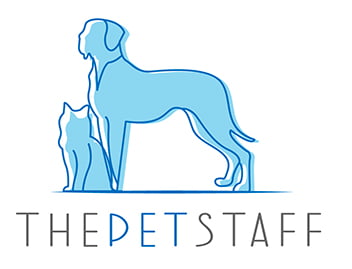The Irish Setter and Poodle mixed breed Irish Doodle also goes by Irish Poo Setter, Irish Doodle Setter, Irish Setterdoodle, and Irish Setterpoo. These lovable dogs are a hybrid of an Irish Setter and a Standard Poodle that are hypoallergenic and full of fun and smarts.
Irish Doodles are like the fiery red version of the beloved Goldendoodle. They are an intelligent, sensitive, and active breed with a fondness for people. They make great family companions as they generally tolerate both children and other animals. Inhibiting hunting dog characteristics like their Irish Setter parents, Irish Doodle may inhibit hunting characteristics like retrieving.
To find out if this cute dog is for you, read on to see about its activity needs, general temperament, grooming requirements, and more.
Breed Characteristics
Temperament | Friendly, outgoing, and intelligent |
Intelligence | High |
Affection/Friendliness | Affectionate and friendly |
Trainability | Highly trainable |
High | |
Exercise Needs | Moderate to high |
Apartment Living | Can adapt |
Family Friendly | Yes |
Pet Friendly | Yes |
Drooling Level | Low to moderate |
Energy Level | Moderate to high |
Loneliness Tolerance | Moderate |
Adaptability | Moderate to high |
Tendency to bark | Moderate |
Origin of Irish Doodles
The exact date and location of the origins of the first Irish Doodle dogs are unknown. Before the 1980s, purposefully crossbreeding dogs to get a designer breed was rare. Most mixed-breed dogs were considered mutts, and parentage was often unknown. Designer breeds became popular in the 80s and 90s with the Labradoodle hybrid, the first intentionally designed dog for hypoallergenic pet owners. As such, the Irish Doodle, whose history as a designer breed is undocumented, probably dates back to the late 90s in the United States.
Irish Doodles were primarily bred for hunting and companionship, being another of the hybrid dog breeds that were at least partially hypoallergenic. While the designer breed does not have a long or known history of its own, it does come from parent stock that is old and impressive. Irish Setters have a history dating back to 18th century Ireland and Poodles originate even further back in 15th century Germany.
The Irish Doodle is a relatively new hybrid dog with no standards or regulations for appearance or temperament. It is not recognized by any major kennel clubs, including the American Kennel Club, but it is recognized by a number of designer dog and rare breed dog clubs.
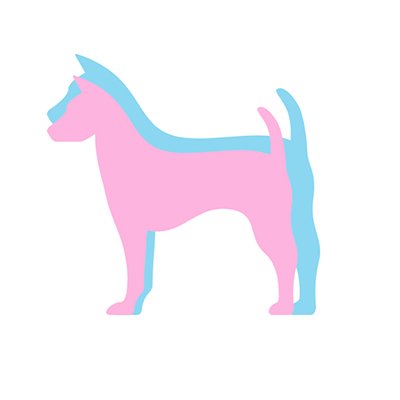
Breed Overview
Height: 24-26"
Weight: 50-75 lbs
Height: 24-26"
Weight: 40-65 lbs
Breed Group
Mixed breed
Life Span
10-15 years
Coat
Double
Coat Length
Medium to long
Hypoallergenic
Potentially
Shedding Level
Moderate
Size
The Irish Doodle is a medium-sized dog breed. The female adult Irish Doodle reaches weights of 40-65 pounds and the males of 50-75 pounds. They grow to be 24-26 inches high.
However, Mini Irish Doodles are available and are much smaller. Miniature Poodle mixed with Irish Setter, mini Irish Doodle stand about 12-17 inches tall and weigh between 25 to 35 pounds with male Irish doodles slightly bigger than female.
Personality
The personality of the Irish Doodle is part of why the dog has become such a popular one. These dogs have pleasant, mellow personalities while still being playful, loving, smart, and loyal family dogs or personal companions.
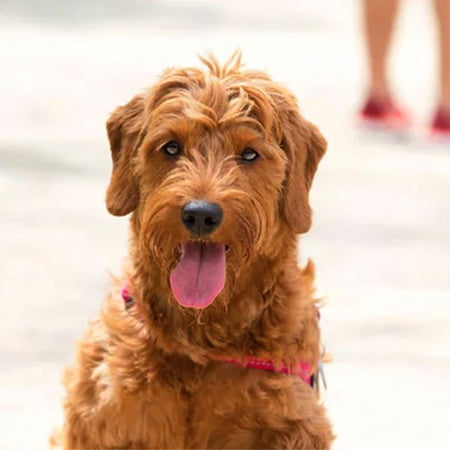
Image source: Deposit photos
Appearance/Colors
The Irish Doodle is a hybrid that looks similar to a goldendoodle, except that an Irish Doodle's coat is usually darker and more red or apricot in color.
Some Irish doodles are black, and sometimes they will have white markings. Their coat is dense, wavy, and long and could be double or single-layered, depending on their setter and poodle parent. Their heads are narrow and elegant, with long muzzles and floppy ears.
Temperament
Irish Doodles have very easy-going and amiable temperaments. These dogs live with their people and make great family dogs. If trained and socialized early, these dogs are great with kids and other pets and will be friendly towards strangers. These dogs make great pets for seniors, singles, or families due to their calm nature.
It should also be noted that while this breed is technically hypoallergenic, But no dog is 100% hypoallergenic, and the more of the Irish Setter in a puppy, the less hypoallergenic it is. Getting a multi-generational puppy with a higher percentage of Poodle is recommended for those wanting a dog with the most hypoallergenic potential.
Diet/Nutritional Needs
The Irish Doodle's dietary needs are average. They should be given quality food, wet or dry, and the quantity or frequency can be discussed with your vet so as to determine the best diet for your dog's age, size, and activity levels.
Irish Doodles can be prone to bloat, so extra care should be taken to avoid overfeeding. You may also choose to split up your dog's meals into two or more smaller meals throughout the day or use a slow food feeder to lower the risk of bloat.
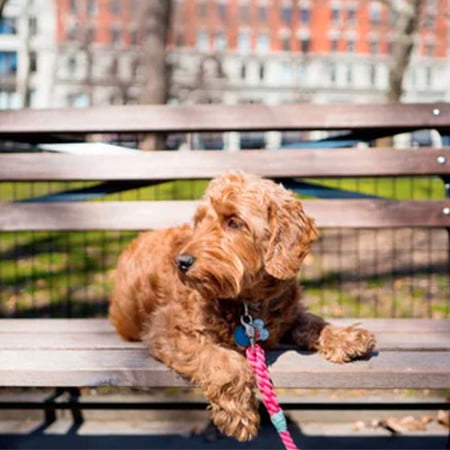
Image source: Deposit photos
Activity/Exercise Needs
The Irish Doodle comes from two breeds of dogs known for their hunting and retrieving skills, so it follows that the hybrid breed requires a good amount of mental and physical stimulation. These dogs should get at least ninety minutes of exercise a day. This can consist of runs, walks, playdates at the dog park, fetch, swimming, or hiking, but Irish Doodles also thrive in dog sports like agility, tracking, and obedience.
An Irish Doodle that is not well exercised will develop negative habits like destructive chewing, boredom, anxiety, and increased barking. Before choosing this breed, you will want to ensure that you have the time or lifestyle to accommodate this dog's average activity levels.
Grooming Needs
The shedding potential for an Irish Doodle varies greatly depending on the coat type any one puppy inherits. Poodles have low shed and hypoallergenic coats, but Irish Setters can shed quite a bit.
Most Irish Doodles can be expected to have low to moderate shedding. But this does not mean they are low-maintenance grooming. Even with a low shedding coat, you may have to brush your Irish Doodle once a day to keep tangles and mats at bay.
Irish Doodles are not a breed that is best bathed or groomed at home since doing so can lead to very bad matting. You should take your Irish Doodle to a professional groomer every four to six weeks if you want to maintain a longer coat. If you clip their coat closer, then they can go a little longer between grooming and may not need to be brushed as often. Their nails should be clipped, and their ears regularly examined for debris, irritation, or infection.
Adaptability
Irish Doodles are quite easy-going and calm pets that get along with most people and pets if they are properly socialized and trained when they are puppies. They thrive best with individuals or families with backyards to run in. But if you can meet their daily activity needs, they could thrive as apartment dogs too. Otherwise, these dogs can become too vocal for small spaces.
They can be a sensitive breed if not socialized, making them shy, easy to frighten, or even make them anxious and stressed. Extra patience and care will be needed to give them a calm environment while they adjust to new things and people.
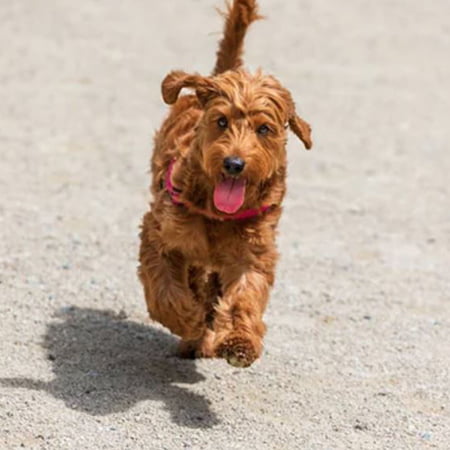
Image source: Deposit photos
The Trainability of Irish Doodle Puppies
Because Irish Doodles combine two very intelligent hunting breeds, they are very trainable. They love to learn, and they love to make their owners happy, so training your Irish Doodle puppy should be easy.
You will need to use positive reinforcement and start quite young with obedience training, but that can easily become the building blocks for more advanced classes or tricks as they get older. Socializing is very important if you want to help your puppy get over being hypersensitive, so you should strive to expose it to many people, creatures, places, and situations while it is young.
Life Expectancy
The life expectancy of a relatively healthy Irish Doodle is 10-15 years.
Cost
Irish Doodle is considered a designer breed. Therefore, Irish Doodle pups can be expensive. Depending on the breeder, they can cost anywhere between $1500 to $5000.
Potential Health Issues
The designer breed is a fairly healthy, hardy, and resilient breed. However, you should always ask to see health reports of both litter parents from a reputable breeder before picking a new puppy. A few common health issues related to the parents' breeds include—
- Hip Dysplasia
- Bloat
- Eye Disorders
- Osteosarcoma
- Von Willebrand's Disease
- Addison's Disease
